
Lydia Ourahmane. In the Absence of our Mothers, 2018. Commissioned and produced by Chisenhale Gallery, London. Photograph: Andy Keate.
by VERONICA SIMPSON
Allegiances – national, emotional, social, religious, political – cut through artist Lydia Ourahmane’s work like the glittering seams of black basalt woven into the structure of our planet. Using sound, sculpture, film and installation, she exposes those fault lines by which our lives – or those of a nation - are decided, for better or worse. It is perhaps not surprising to find that narrative woven into her personal life, even at the relatively youthful age of 25. Ourahmane, who was born in Algeria in 1992, relocated with her family to the UK at the age of nine, and now bases herself in London and Algeria, returning to Oran, and her family home, whenever she can. But where her previous works, especially Third Choir (2014) and pH 8.7 (2015), interrogated the complex and self-destructive politics of the region, her newly commissioned installation at the Chisenhale Gallery has gone deep into her own family’s history, revealing a pattern of self-sacrifice and intense attachment to Algeria as homeland that binds each generation; she contrasts this with the mood of Algeria today, where the young appear to dream only of escape.
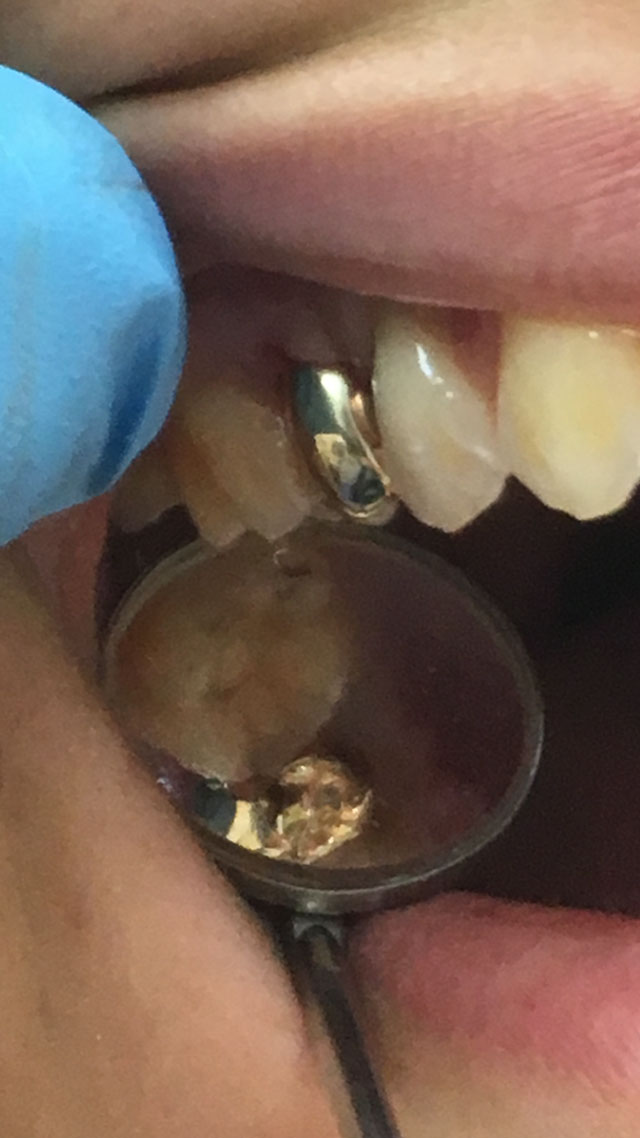
Lydia Ourahmane. In the Absence of our Mothers, 2018. Commissioned and produced by Chisenhale Gallery, London. Photograph: Andy Keate.
Embedded or embodied trauma are also key themes for Ourahmane, and in this show, called The You In Us, she has embedded an artwork in herself. In the Absence of Our Mothers (2015-18) is a gold tooth, which sits in the gallery, displayed on the wall; the real point is, however, that its twin is implanted in Ourahmane’s mouth. The piece has had a slow evolution, originating when she bought a gold chain from a young man in an Algerian market in 2015. He said he was selling it for his mother, but the price he asked – €300 – was the price she had, coincidentally, just found out to be the going rate for smuggling people out of the country. She paid it, intrigued by the conflicting loyalties the act displayed, but was unsure how to use the chain until, while spending time in Oran in 2017, she heard the full details of her grandfather’s history. As a young man living under French colonial rule, he was drafted into the French-Algerian army in 1933, where he proved to be a talented sniper. In 1945, to avoid being sent abroad to fight for France in the second world war, he pulled out all his teeth (this was the only way you could be dismissed from the army without legal retribution). She decided then to melt down the gold necklace and have a pair of identical teeth made, one of which has been drilled into her skull. Beside the tooth, in the gallery, is an x-ray of her mouth, showing where an existing gap among her molars was to be prepared for its gold replacement.
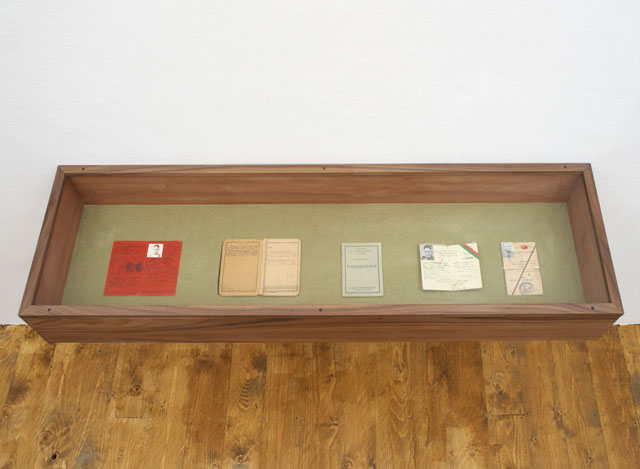
Lydia Ourahmane. Droit de Sand (Blood Right), 2018. Commissioned and produced by Chisenhale Gallery, London. Photograph: Andy Keate.
Her grandfather went on to play a major role in the resistance, fighting against the French for independence for both Algeria and Morocco. In a display case next to the solitary tooth, Ourahmane has arranged a series of documents – her grandfather’s military conscription card (1933), his military records (1933), his French passport (1954) and proofs of his participation in the resistance. She displays these not to showcase her grandfather’s achievements, but to flag up that these documents are currently being used by members of her family to prove they have a right to French citizenship – “blood rights”; another shift in allegiances – a “paradigm shift”, as Ourahmane has called it – revealing a desire by the formerly oppressed to return to the oppressor.
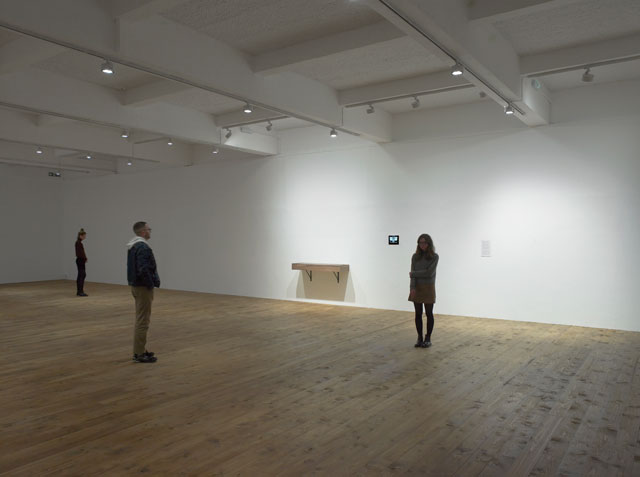
Lydia Ourahmane. The you in us, 2018. Installation view, Chisenhale Gallery, 2018. Commissioned and produced by Chisenhale Gallery, London. Photograph: Andy Keate.
Underneath our feet is an even more resonant work, Paradis (2018), a sound work embedded in, and amplified by, a new, temporary wooden floor installed over the Chisenhale’s concrete one, blending sound from field recordings she made while in Oran with music she composed and performed together with her friends, mostly in Algeria.
The final element in the installation (although it is also the first we encounter) is Doors (2018): two heavy silver doors into and out of the gallery, blackened with sulphur. Ourahmane hopes that as people touch and handle them, the sulphur will wear off, revealing the silver underneath, mapping the activities and the presence of those who have passed through.
-Lydia-Ourahmane-at-Chisenhale-Gallery_01.jpg)
Lydia Ourahmane. Doors, 2018. Commissioned and produced by Chisenhale Gallery, London. Photograph: Andy Keate.
Only recently graduated – from Goldsmiths, University of London – Ourahmane made an impact with her final degree piece: The Third Choir (2014). It comprised 20 Naftal oil barrels, which she went to great pains to export from Algeria, to highlight the complexities of movement between borders, but also the fact that these particular drums contain oil from Algeria’s own wells, and yet this brand never leaves the country. Algeria has wealth, but the people at large never benefit from it: the oil is always sold on to Shell. The barrels each contained a mobile phone, which broadcast a sound piece she composed in the region.
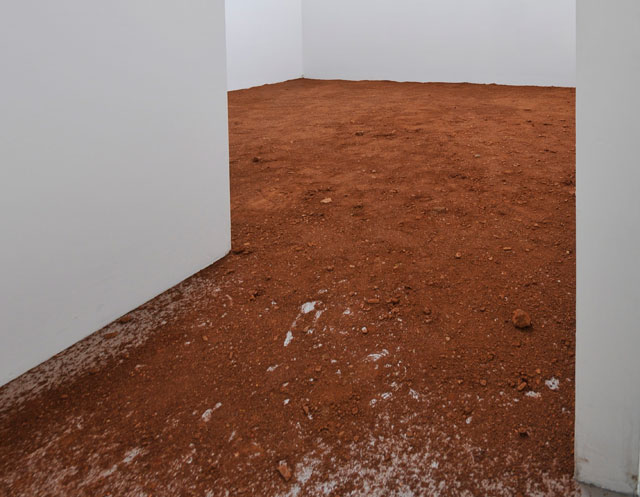
Lydia Ourahmane. p.H 8.7, 2015. Fertile soil smuggled from Medea, Algeria. Installation view Ellis King, Dublin, 2015. Courtesy the artist.
For pH 8.7 (2015), she smuggled 356 kilos of soil from along Algeria’s “trail of death” – an area that has been decimated through terrorist activity, but which is also incredibly fertile and still used for growing food. The work was shown at the Espace Arlaud, Lausanne, Switzerland, as part of Natural Instincts (2015).
Ourahmane graduated from Goldsmiths with a BA in fine art in 2014. She has exhibited at the ICA, London (2014), Art Berlin Contemporary (2015), Palais de la Culture Algeria (2015), the Zachęta National Gallery of Art, Warsaw (2016), the 15th Istanbul Biennial (2017) and Garage Rotterdam, Netherlands (2017). As well as her exhibition at the Chisenhale Gallery, Ourahmane is currently part of a group show at the New Museum of Contemporary Art 2018 Triennial: Songs for Sabotage, New York.
Veronica Simpson: At a talk in December at the Chisenhale, one of the things that seemed to shock and fascinate the audience was that you would respond to your grandfather’s gesture of removing his teeth by having your own mouth drilled to prepare for this gold tooth.
Lydia Ourahmane: I feel that trauma already exists. So many people ask me about that process of dental implantation and talk about it as a very violent act. I don’t see that as any different from anything else I have done. I really don’t. For me, it’s a way of understanding what this history is. It makes it literally a way of understanding it. I guess I use my work to try to sift through what everything means. I’ve only been on this planet a short time. The work I make today I won’t be making in 15 years’ time, so working with this personal history is something I have to deal with now, as a way of moving forward.
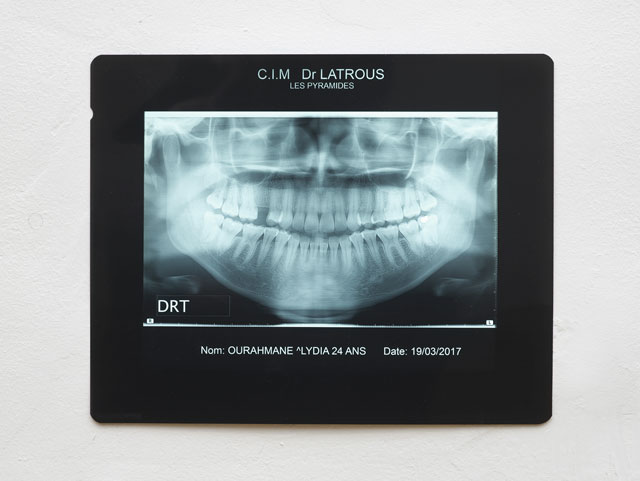
Lydia Ourahmane. In the Absence of our Mothers, 2018. Commissioned and produced by Chisenhale Gallery, London. Photograph: Andy Keate.
VS: It is a fascinating way of uniting different narratives in the show – allegiance and betrayal.
LO: It’s the same gesture, performed with absolute commitment. For this boy to have potentially stolen this necklace from his mum, to go against your blood in order to achieve something, or do this thing, which also is done against the knowledge of the family …
I guess it reflects on what my grandfather’s generation fought for and what this current generation is doing. The two gestures are of the same degree but totally opposing. It totally made sense, this act of finitude, something that is irreversible - and pulling teeth is irreversible. It was important that there were two of these objects, to draw out the relationship between them. The relationship is always integral. They would be of the same flesh but would exist in two different places.
People of my grandfather’s generation, the really old people in Algeria, always comment: “This isn’t what we fought for.” It’s like a huge exodus of young people wanting to get out of there because they don’t feel they are able to exist in that place, there are no opportunities for them.
VS: You spent three months in Algeria as part of this Chisenhale commission, but you had actually spent a year living there, and in that time, your relationship to this important place has shifted.
LO: Yes, it had always existed in this realm of nostalgia, where you attach memories to a place which are … huge exaggerations of what you remember it was. I’ve always been very romantic about what that place is and the light and the energy and the people. But I feel like this year was so difficult, it really interrogated what I’d thought I previously felt about that place, that place as home. It really pushed it.
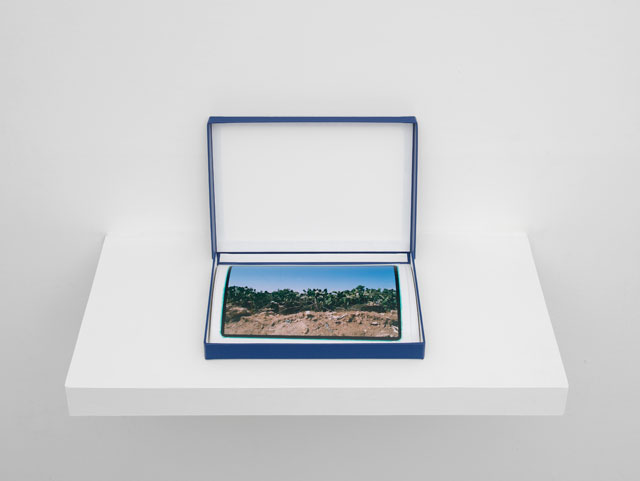
Lydia Ourahmane. Notes on the wait, 2018. Limited edition. Commissioned and produced by Chisenhale Gallery, London. Photograph: Andy Keate.
VS: There was one particular incident that has found its way into the work – people broke into your house and stole your dogs one night.
LO: Like all the works I’ve done, the work sheds light on a system that has been able to exist, which is why the country is in this mess. When the dogs were stolen, I tried to report it to the police, and they said you can’t report it unless you have the names of the people you think have done it. So I had to go on a wild goose chase trying to find these people, which put me at the forefront of this investigation. And then I was immediately extremely vulnerable because I ended up giving the police the names. I asked: “Can you go and search their houses?” And they said: “We can, but you have to knock on the doors first.” So they took me to the houses and I had to knock on the door and six of them would be stood behind me and they would go in after me.
How can this system be conducive to anything like justice? And then I completely understood why no one trusts the police and no one trusts the government. And it really has shifted the way the community works. There’s no trust because there’s no one who is accountable.
VS: I was reading in your interview with the curator of this exhibition, Ellen Greig, that you spent quite a lot of time with these young people – specifically seeking out those you thought might have had a hand in stealing your dogs. It’s a brave but fascinating way of tackling these issues head on; get to the unpalatable truths. How did the decision to use these incidents in the work arise? (photos appear in Notes on the Wait, and audio snippets are in the sound piece Paradis).
LO: I was using a binaural sound recorder when I was in the process of looking for the dogs, I just had it recording all the time, so that if something happened I would have evidence of it. A lot of it was just me walking down the road or having conversations or driving around with these guys. I decided this is as important as anything else. Why does it have to be all about the main event – the anticipation of the event? All these spaces are about waiting, which is what these young people are doing. Especially in this area where I’m living (Oran) because it’s a beach town. So many people have gone. In every interaction with someone young, they’re talking about how far along they are in the process of leaving - who they’re going to go with, how they’re going to do it. I was kind of looking at it – taking a step back – looking at this group of people in this state of waiting. That same kind of feeling was in the sound recordings of that area, when I was waiting for something. I realised this is also a space that is extremely important, and so potent. Then I looked at the photos I produced for the edition of Notes on the Wait. What I see is a backdrop, this idea of waiting: landscapes or areas within which people are projecting their future.
VS: What is the intention behind the sound piece? In the December talk, you said: “Sound has presence in time and place, and you can allow things to heal.”
LO: The space that is lacking in that community, in this very specific context, is a space of respite. And the feelings that are pushing them to leave the country, maybe all they need is a little bit of time out? I’m not saying that’s the only thing that people are seeking, but people think of Europe as this place of [fantasy]. It’s always interesting to speak to people about what they think Europe is … somewhere they have only experienced within the realm of secondary information. A lot of the conversations I have with young people, they tell me they use Facebook. They look for (European sounding) people’s names, and go through photos to see what they do. And yet, on Facebook, people only post things that they feel are great.
VS: It’s a very skewed version of reality.
LO: But for that to physically move that person to make them risk their lives to try to attain this space, I find that incredible.
VS: So there are these elements of conflict in the Chisenhale space, and also elements of resolution. But rather than just play the piece over speakers, you have replaced the floor and turned that into a musical instrument.
LO: I was using these transducer speakers, also used in sound therapy, to play this continuous melodic frequency through the body, which induces a state of calm. That’s why there are these waves going through the floor, which you can follow around the room. The editing process was pretty insane. There are eight sound channels, and one consistent movement in the space and everything is interlaid around it. When there are conversations (on the soundtrack) they move around the space, and you can follow them, or you can lie down or sit down. I told the Chisenhale to take the lights really low, so people are not conscious of being looked at. It was so nice at the opening, everyone there really stayed in the room chatting. There was a really nice atmosphere. When I go to a private viewing, I usually want to get out as soon as possible. That aspect of gallery space I’ve never felt comfortable with – here’s the big show and all the lights are on.
VS: But there is a lot of attention on you right now: at the same time as preparing for the Chisenhale opening, you have been working on a piece for New York, for the New Museum Triennial.
LO: It’s a big group show, about 30 of us. I’m making this thing that’s going to be destroyed over the course of the show. It’s in this 14-foot shaft space, so you go upstairs and it’s a wall, plastered with calcium, chalk, and then the sound will vibrate the calcium off, it will be falling. And downstairs people will be walking it around. Calcium is so interesting, because it’s literally decayed matter, and we all turn into calcium in the end. Even that material is like so many different things. So, to start with, it will look like a wall. Slowly it will become this thing that is not a wall.
VS: It must be very exciting having this momentum, this interest building around your work?
LO: Yes, I’m very humbled by it all.
VS: What do you think of this art world that you are being drawn into?
LO: I really think you can negotiate it how you want. You don’t have to play by some rules. I don’t see it as a system. For me, if you’re making good work and really zeroing in on what you’re doing, you don’t need to play these games because, at the end of the day, your work will live beyond you. And what your momentary interactions could be are just not even relevant. All my friends are musicians. They’re in the music world. That’s my life, my thing.
VS: You said there were lots of people you knew from Goldsmiths – tutors as well as friends – at the opening. How was Goldsmiths as a place to study?
LO: I had a really amazing three years. Having said that, I nearly dropped out in the first year. There’s so much competition already to get in, and when you get there the critical environment can be overwhelming but that is what made Goldsmiths such an integral part of my education.
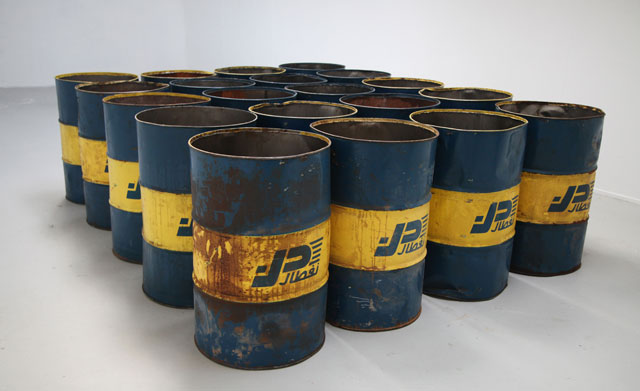
Lydia Ourahmane. The Third Choir, 2014-15. 20 x Naftal Oil Barrels imported from Algeria, CZ-5HE Radio Transmitter, 20 x Samsung E2121B Phones. Installation view Ellis King, Dublin, 2015. Courtesy the artist.
VS: How did you move past that?
LO: In my third year, I had amazing support from my tutors; Gail Pickering, Edgar Schmidz and Michael Archer. That’s when I started working on the Third Choir, the barrel piece. Toward the end of that work they were really involved in some of the bureaucratic exchanges that facilitated that work. I realise none of the other stuff matters. This is what I’m doing. This idea that art can actually have an impact in real, physical world terms: it has the ability to move beyond what you think and what you’re concerned with into dealing with bigger issues. It was refreshing, and I guess what gave me the impetus to continue working.
VS: And are you happy with this Chisenhale show?
LO: The last time I felt like this was the time I finished the barrel piece. I feel happy with this outcome. For me, that’s very hard to feel like that. It is a nice feeling.
• Lydia Ourahmane: The You In Us is at the Chisenhale Gallery, London, until 25 March 2018. 2018 Triennial: Songs for Sabotage is at the New Museum of Contemporary Art, New York, until 27 May 2018.